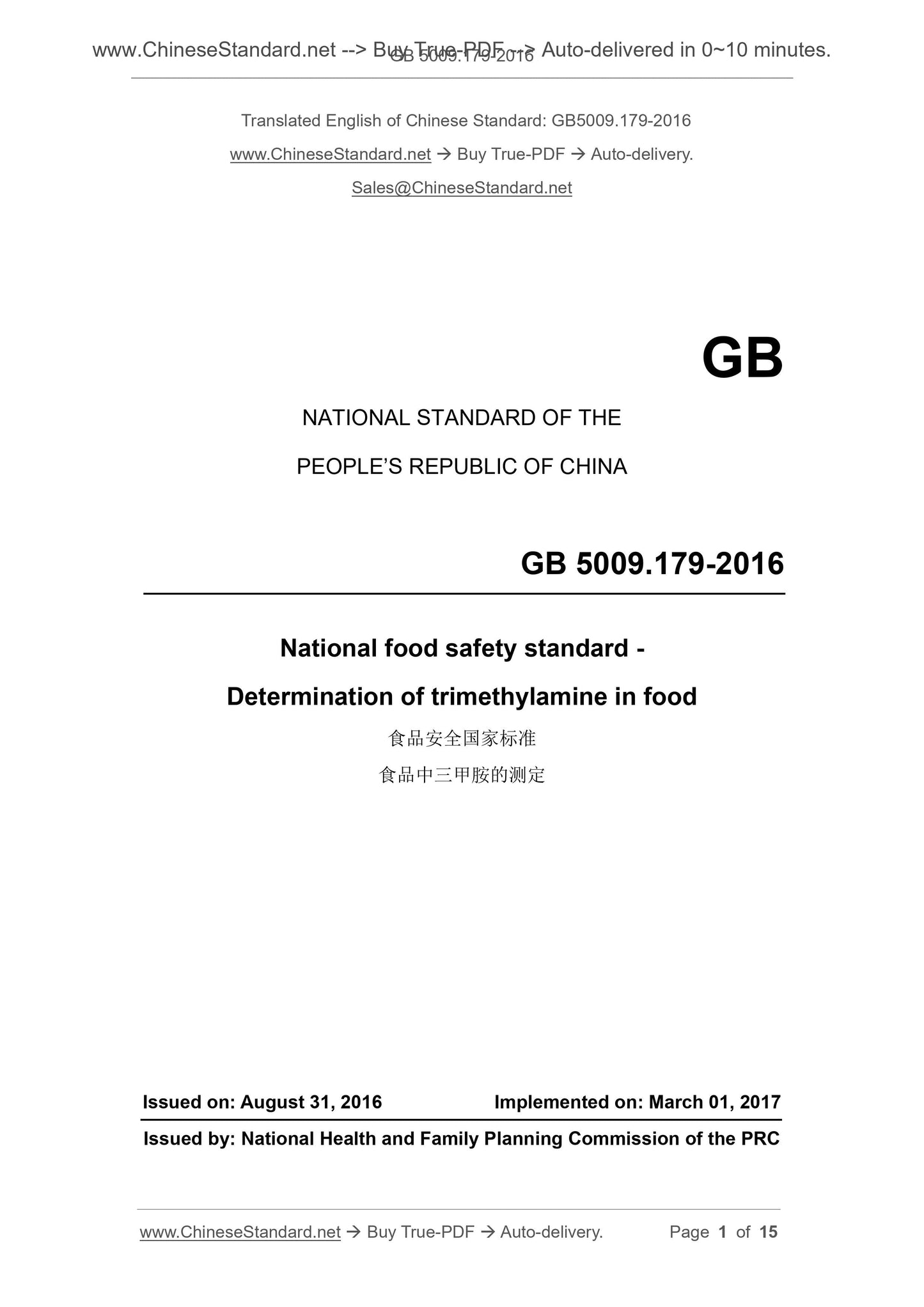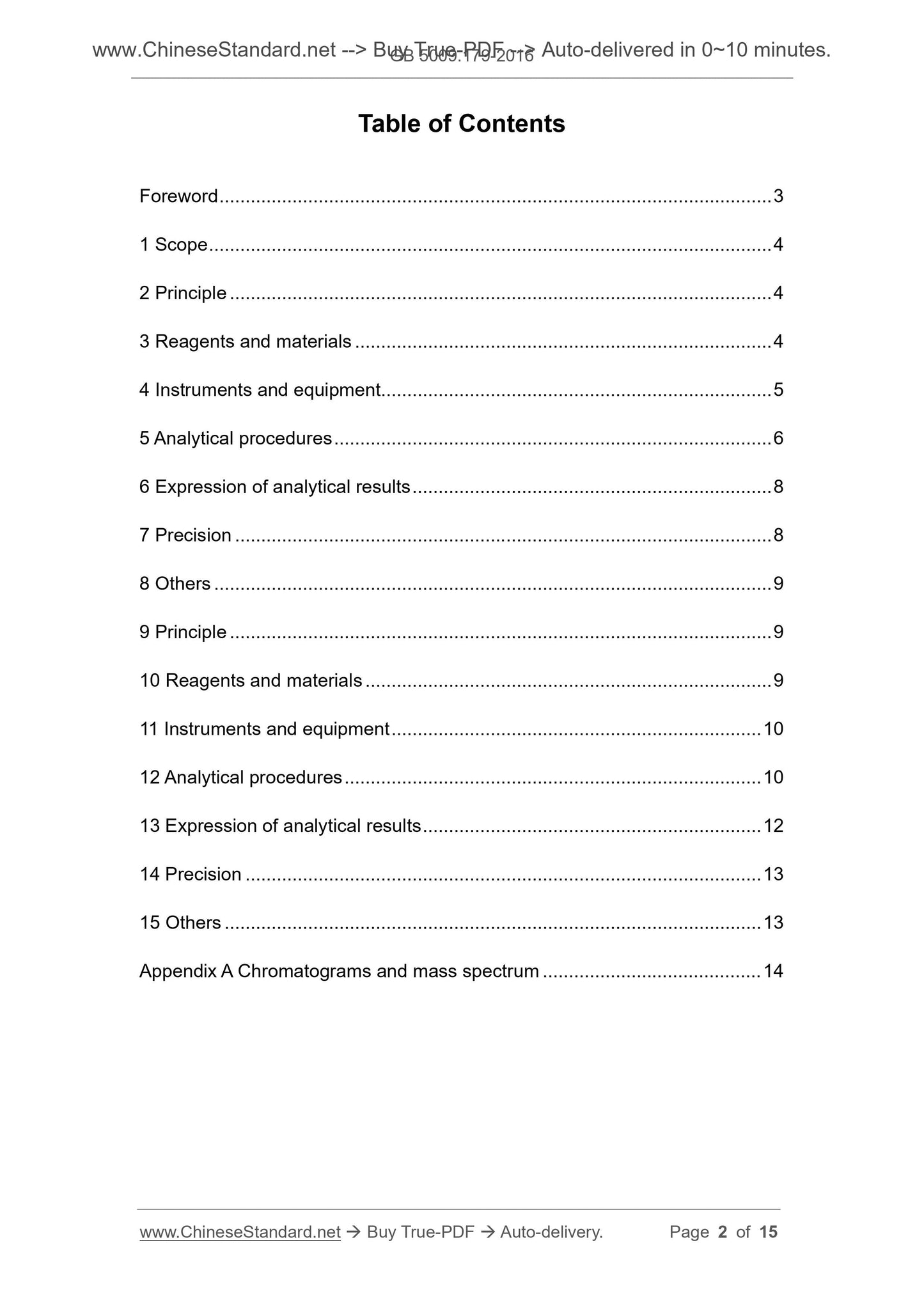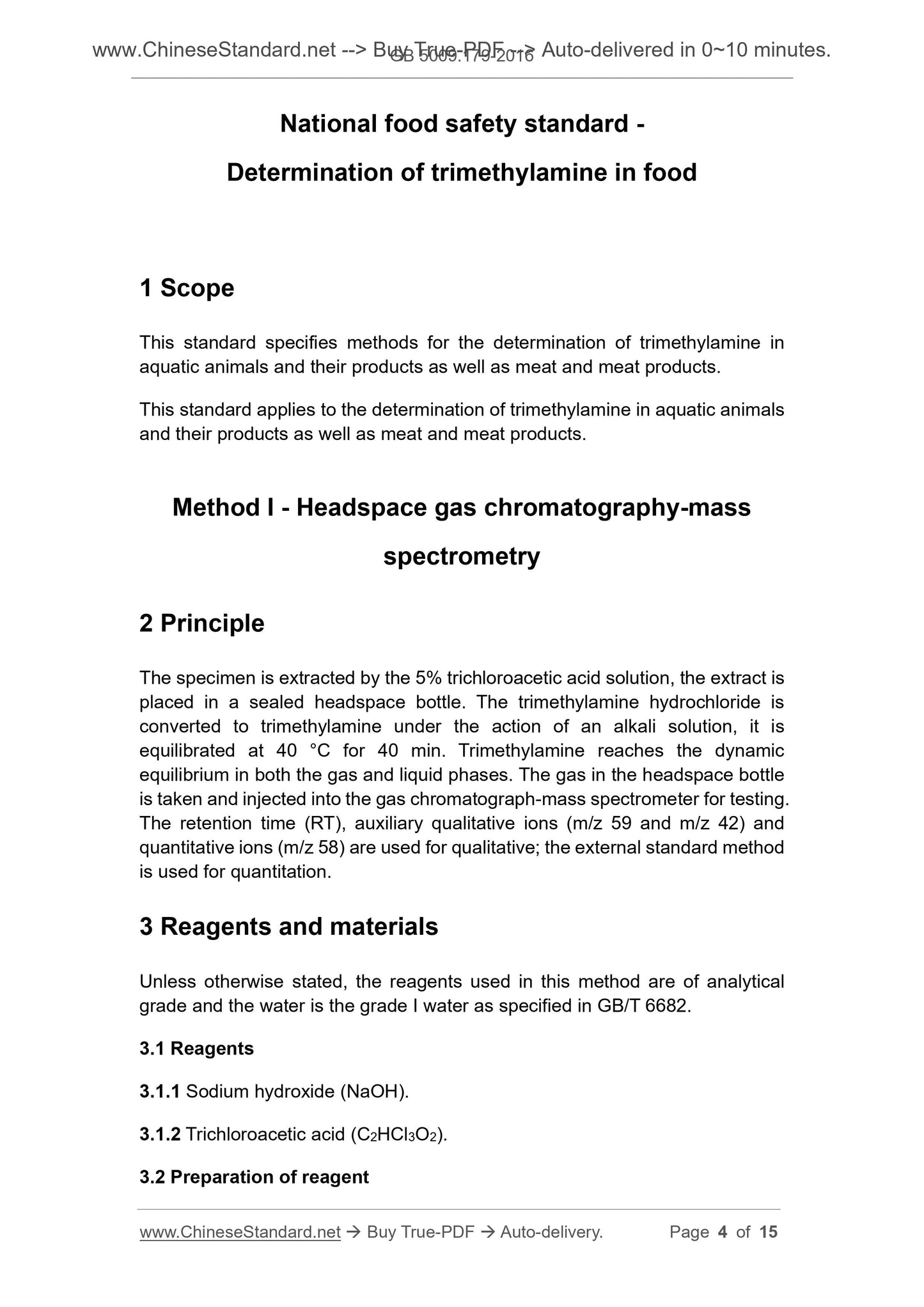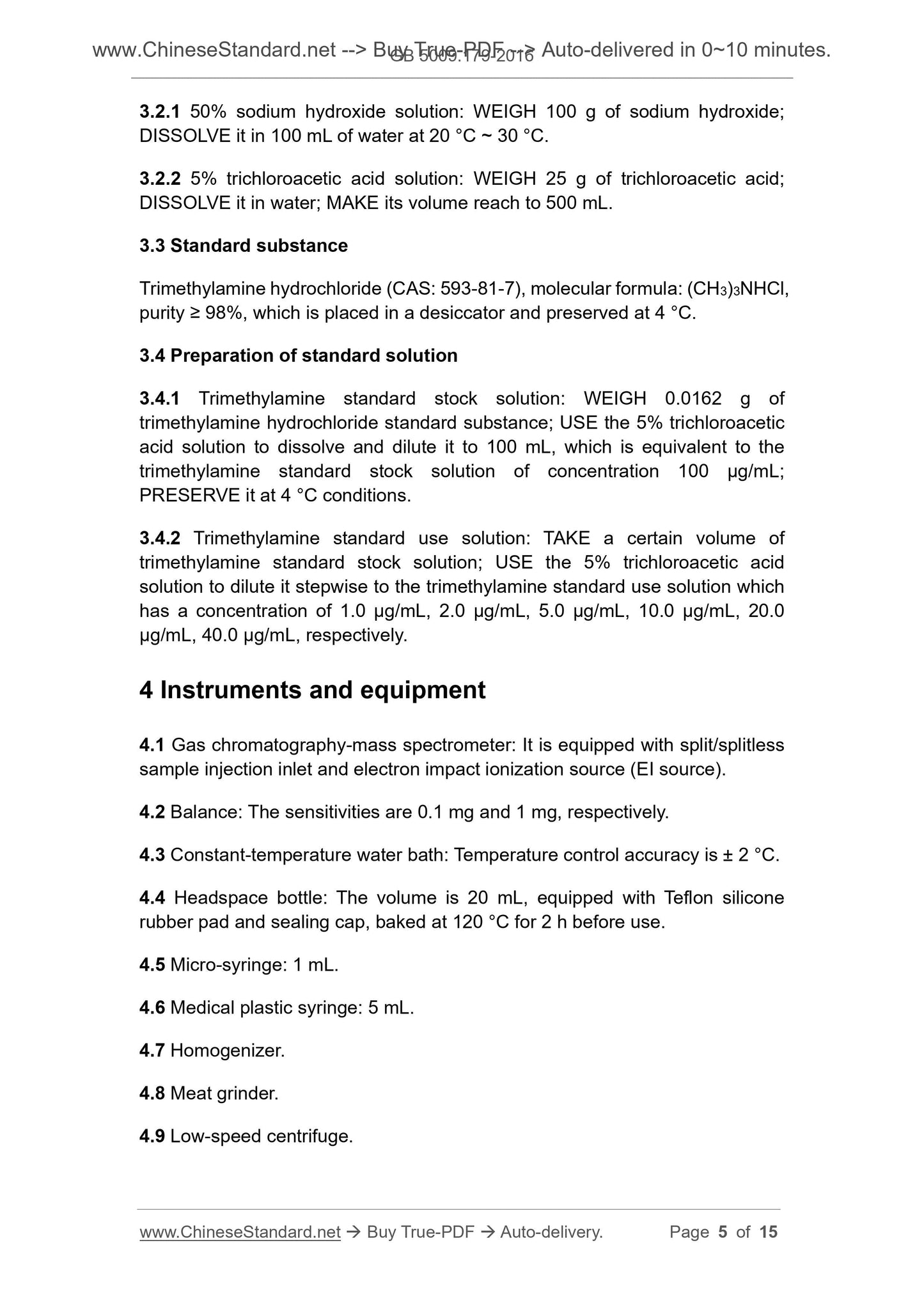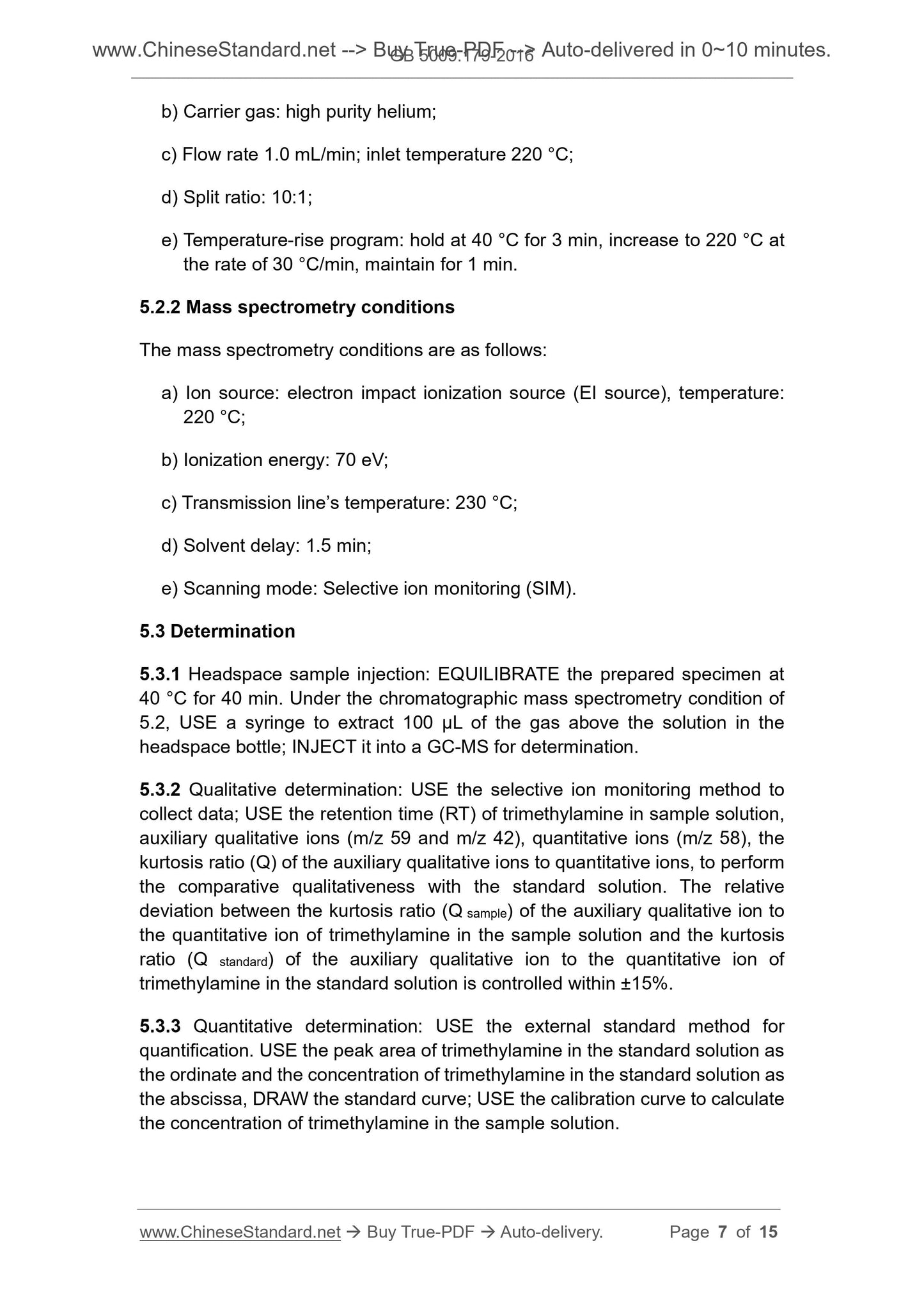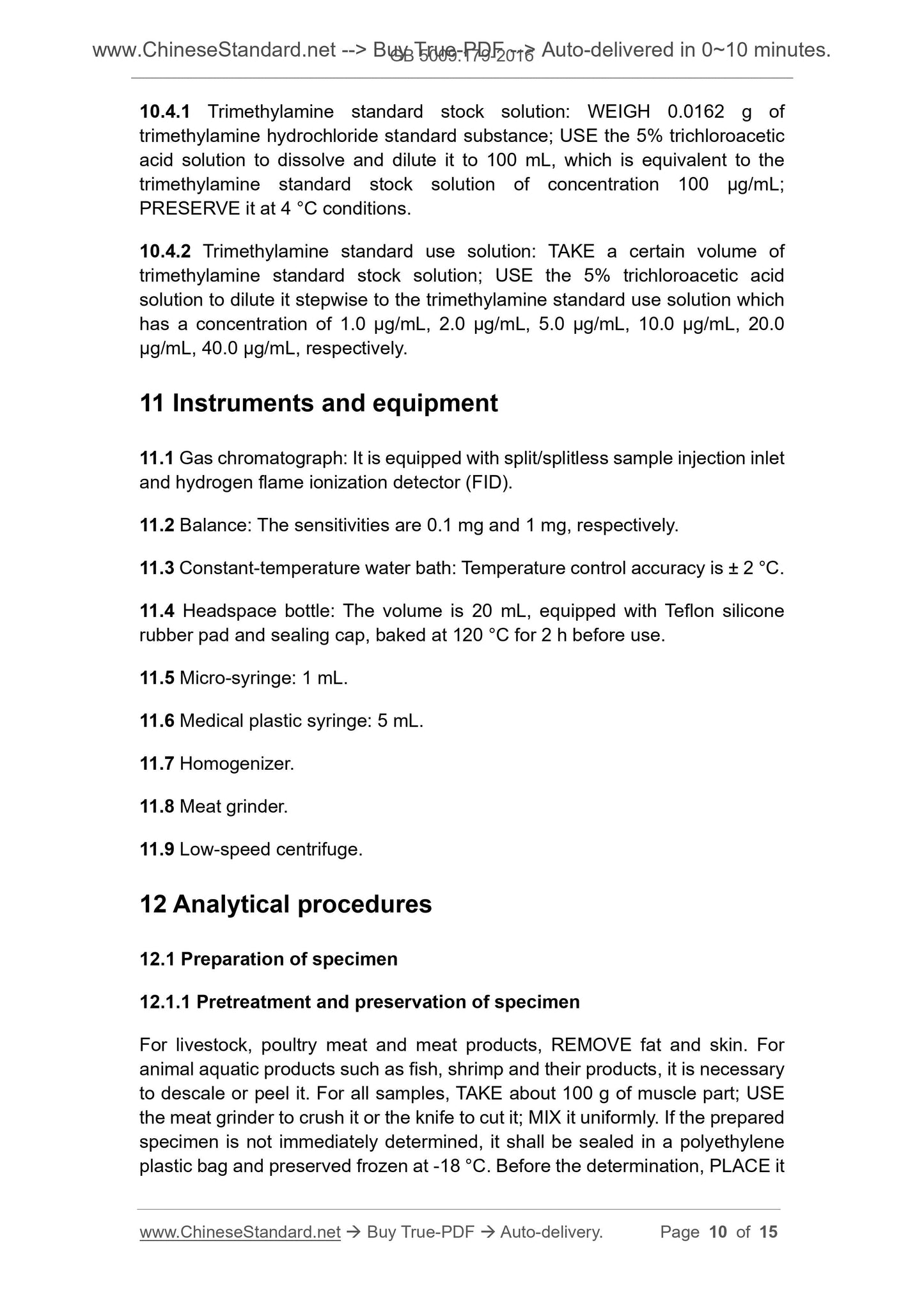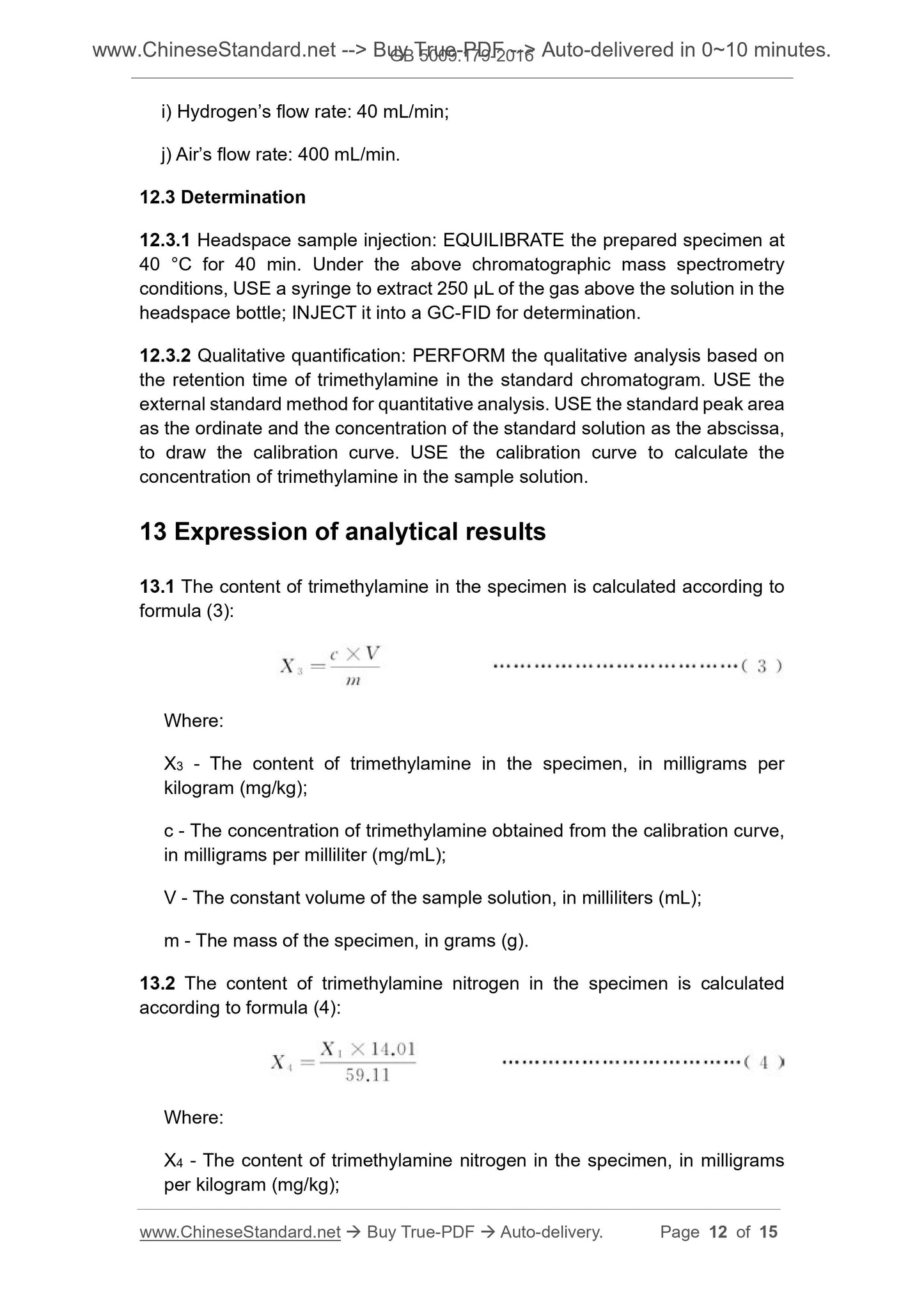1
/
of
7
www.ChineseStandard.us -- Field Test Asia Pte. Ltd.
GB 5009.179-2016 English PDF
GB 5009.179-2016 English PDF
Regular price
$85.00
Regular price
Sale price
$85.00
Unit price
/
per
Shipping calculated at checkout.
Couldn't load pickup availability
GB 5009.179-2016: National food safety standard - Determination of trimethylamine in food
Delivery: 9 seconds. Download (& Email) true-PDF + Invoice.
Get Quotation: Click GB 5009.179-2016 (Self-service in 1-minute)
Historical versions (Master-website): GB 5009.179-2016
Preview True-PDF (Reload/Scroll-down if blank)
GB 5009.179-2016
GB
NATIONAL STANDARD OF THE
PEOPLE’S REPUBLIC OF CHINA
National food safety standard -
Determination of trimethylamine in food
ISSUED ON. AUGUST 31, 2016
IMPLEMENTED ON. MARCH 01, 2017
Issued by. National Health and Family Planning Commission of the PRC
Table of Contents
Foreword ... 3
1 Scope ... 4
2 Principle ... 4
3 Reagents and materials ... 4
4 Instruments and equipment... 5
5 Analytical procedures ... 6
6 Expression of analytical results ... 8
7 Precision ... 8
8 Others ... 9
9 Principle ... 9
10 Reagents and materials ... 9
11 Instruments and equipment ... 10
12 Analytical procedures ... 10
13 Expression of analytical results ... 12
14 Precision ... 13
15 Others ... 13
Appendix A Chromatograms and mass spectrum ... 14
National food safety standard -
Determination of trimethylamine in food
1 Scope
This standard specifies methods for the determination of trimethylamine in
aquatic animals and their products as well as meat and meat products.
This standard applies to the determination of trimethylamine in aquatic animals
and their products as well as meat and meat products.
Method I - Headspace gas chromatography-mass
spectrometry
2 Principle
The specimen is extracted by the 5% trichloroacetic acid solution, the extract is
placed in a sealed headspace bottle. The trimethylamine hydrochloride is
converted to trimethylamine under the action of an alkali solution, it is
equilibrated at 40 °C for 40 min. Trimethylamine reaches the dynamic
equilibrium in both the gas and liquid phases. The gas in the headspace bottle
is taken and injected into the gas chromatograph-mass spectrometer for testing.
The retention time (RT), auxiliary qualitative ions (m/z 59 and m/z 42) and
quantitative ions (m/z 58) are used for qualitative; the external standard method
is used for quantitation.
3 Reagents and materials
Unless otherwise stated, the reagents used in this method are of analytical
grade and the water is the grade I water as specified in GB/T 6682.
3.1 Reagents
3.1.1 Sodium hydroxide (NaOH).
3.1.2 Trichloroacetic acid (C2HCl3O2).
3.2 Preparation of reagent
3.2.1 50% sodium hydroxide solution. WEIGH 100 g of sodium hydroxide;
DISSOLVE it in 100 mL of water at 20 °C ~ 30 °C.
3.2.2 5% trichloroacetic acid solution. WEIGH 25 g of trichloroacetic acid;
DISSOLVE it in water; MAKE its volume reach to 500 mL.
3.3 Standard substance
Trimethylamine hydrochloride (CAS. 593-81-7), molecular formula. (CH3)3NHCl,
purity ≥ 98%, which is placed in a desiccator and preserved at 4 °C.
3.4 Preparation of standard solution
3.4.1 Trimethylamine standard stock solution. WEIGH 0.0162 g of
trimethylamine hydrochloride standard substance; USE the 5% trichloroacetic
acid solution to dissolve and dilute it to 100 mL, which is equivalent to the
trimethylamine standard stock solution of concentration 100 μg/mL;
PRESERVE it at 4 °C conditions.
3.4.2 Trimethylamine standard use solution. TAKE a certain volume of
trimethylamine standard stock solution; USE the 5% trichloroacetic acid
solution to dilute it stepwise to the trimethylamine standard use solution which
has a concentration of 1.0 μg/mL, 2.0 μg/mL, 5.0 μg/mL, 10.0 μg/mL, 20.0
μg/mL, 40.0 μg/mL, respectively.
4 Instruments and equipment
4.1 Gas chromatography-mass spectrometer. It is equipped with split/splitless
sample injection inlet and electron impact ionization source (EI source).
4.2 Balance. The sensitivities are 0.1 mg and 1 mg, respectively.
4.3 Constant-temperature water bath. Temperature control accuracy is ± 2 °C.
4.4 Headspace bottle. The volume is 20 mL, equipped with Teflon silicone
rubber pad and sealing cap, baked at 120 °C for 2 h before use.
4.5 Micro-syringe. 1 mL.
4.6 Medical plastic syringe. 5 mL.
4.7 Homogenizer.
4.8 Meat grinder.
4.9 Low-speed centrifuge.
b) Carrier gas. high purity helium;
c) Flow rate 1.0 mL/min; inlet temperature 220 °C;
d) Split ratio. 10.1;
e) Temperature-rise program. hold at 40 °C for 3 min, increase to 220 °C at
the rate of 30 °C/min, maintain for 1 min.
5.2.2 Mass spectrometry conditions
The mass spectrometry conditions are as follows.
a) Ion source. electron impact ionization source (EI source), temperature.
220 °C;
b) Ionization energy. 70 eV;
c) Transmission line’s temperature. 230 °C;
d) Solvent delay. 1.5 min;
e) Scanning mode. Selective ion monitoring (SIM).
5.3 Determination
5.3.1 Headspace sample injection. EQUILIBRATE the prepared specimen at
40 °C for 40 min. Under the chromatographic mass spectrometry condition of
5.2, USE a syringe to extract 100 μL of the gas above the solution in the
headspace bottle; INJECT it into a GC-MS for determination.
5.3.2 Qualitative determination. USE the selective ion monitoring method to
collect data; USE the retention time (RT) of trimethylamine in sample solution,
auxiliary qualitative ions (m/z 59 and m/z 42), quantitative ions (m/z 58), the
kurtosis ratio (Q) of the auxiliary qualitative ions to quantitative ions, to perform
the comparative qualitativeness with the standard solution. The relative
deviation between the kurtosis ratio (Q sample) of the auxiliary qualitative ion to
the quantitative ion of trimethylamine in the sample solution and the kurtosis
ratio (Q standard) of the auxiliary qualitative ion to the quantitative ion of
trimethylamine in the standard solution is controlled within ±15%.
5.3.3 Quantitative determination. USE the external standard method for
quantification. USE the peak area of trimethylamine in the standard solution as
the ordinate and the concentration of trimethylamine in the standard solution as
the abscissa, DRAW the standard curve; USE the calibration curve to calculate
the concentration of trimethylamine in the sample solution.
10.4.1 Trimethylamine standard stock solution. WEIGH 0.0162 g of
trimethylamine hydrochloride standard substance; USE the 5% trichloroacetic
acid solution to dissolve and dilute it to 100 mL, which is equivalent to the
trimethylamine standard stock solution of concentration 100 μg/mL;
PRESERVE it at 4 °C conditions.
10.4.2 Trimethylamine standard use solution. TAKE a certain volume of
trimethylamine standard stock solution; USE the 5% trichloroacetic acid
solution to dilute it stepwise to the trimethylamine standard use solution which
has a concentration of 1.0 μg/mL, 2.0 μg/mL, 5.0 μg/mL, 10.0 μg/mL, 20.0
μg/mL, 40.0 μg/mL, respectively.
11 Instruments and equipment
11.1 Gas chromatograph. It is equipped with split/splitless sample injection inlet
and hydrogen flame ionization detector (FID).
11.2 Balance. The sensitivities are 0.1 mg and 1 mg, respectively.
11.3 Constant-temperature water bath. Temperature control accuracy is ± 2 °C.
11.4 Headspace bottle. The volume is 20 mL, equipped with Teflon silicone
rubber pad and sealing cap, baked at 120 °C for 2 h before use.
11.5 Micro-syringe. 1 mL.
11.6 Medical plastic syringe. 5 mL.
11.7 Homogenizer.
11.8 Meat grinder.
11.9 Low-speed centrifuge.
12 Analytical procedures
12.1 Preparation of specimen
12.1.1 Pretreatment and preservation of specimen
For livestock, poultry meat and meat products, REMOVE fat and skin. For
animal aquatic products such as fish, shrimp and their products, it is necessary
to descale or peel it. For all samples, TAKE about 100 g of muscle part; USE
the meat grinder to crush it or the knife to cut it; MIX it uniformly. If the prepared
specimen is not immediately determined, it shall be sealed in a polyethylene
plastic bag and preserved frozen at -18 °C. Before the determination, PLACE it
i) Hydrogen’s flow rate. 40 mL/min;
j) Air’s flow rate. 400 mL/min.
12.3 Determination
12.3.1 Headspace sample injection. EQUILIBRATE the prepared specimen at
40 °C for 40 min. Under the above chromatographic mass spectrometry
conditions, USE a syringe to extract 250 μL of the gas above the solution in the
headspace bottle; INJECT it into a GC-FID for determination.
12.3.2 Qualitative quantification. PERFORM the qualitative analysis based on
the retention time of trimethylamine in the standard chromatogram. USE the
external standard method for quantitative analysis. USE the standard peak area
as the ordinate and the concentration of the standard solution as the abscissa,
to draw the calibration curve. USE the calibration curve to calculate the
concentration of trimethylamine in the sample solution.
13 Expression of analytical results
13.1 The content of trimethylamine in the specimen is calculated according to
formula (3).
Where.
X3 - The content of trimethylamine in the specimen, in milligrams per
kilogram (mg/kg);
c - The concentration of trimethylamine obtained from the calibration curve,
in milligrams per milliliter (mg/mL);
V - The constant volume of the sample solution, in milliliters (mL);
m - The mass of the specimen, in grams (g).
13.2 The content of trimethylamine nitrogen in the specimen is calculated
according to formula (4).
Where.
X4 - The content of trimethylamine nitrogen in the specimen, in milligrams
per kilogram (mg/kg);
GB 5009.179-2016
GB
NATIONAL STANDARD OF THE
PEOPLE’S REPUBLIC OF CHINA
National food safety standard -
Determination of trimethylamine in food
ISSUED ON. AUGUST 31, 2016
IMPLEMENTED ON. MARCH 01, 2017
Issued by. National Health and Family Planning Commission of the PRC
Table of Contents
Foreword ... 3
1 Scope ... 4
2 Principle ... 4
3 Reagents and materials ... 4
4 Instruments and equipment... 5
5 Analytical procedures ... 6
6 Expression of analytical results ... 8
7 Precision ... 8
8 Others ... 9
9 Principle ... 9
10 Reagents and materials ... 9
11 Instruments and equipment ... 10
12 Analytical procedures ... 10
13 Expression of analytical results ... 12
14 Precision ... 13
15 Others ... 13
Appendix A Chromatograms and mass spectrum ... 14
National food safety standard -
Determination of trimethylamine in food
1 Scope
This standard specifies methods for the determination of trimethylamine in
aquatic animals and their products as well as meat and meat products.
This standard applies to the determination of trimethylamine in aquatic animals
and their products as well as meat and meat products.
Method I - Headspace gas chromatography-mass
spectrometry
2 Principle
The specimen is extracted by the 5% trichloroacetic acid solution, the extract is
placed in a sealed headspace bottle. The trimethylamine hydrochloride is
converted to trimethylamine under the action of an alkali solution, it is
equilibrated at 40 °C for 40 min. Trimethylamine reaches the dynamic
equilibrium in both the gas and liquid phases. The gas in the headspace bottle
is taken and injected into the gas chromatograph-mass spectrometer for testing.
The retention time (RT), auxiliary qualitative ions (m/z 59 and m/z 42) and
quantitative ions (m/z 58) are used for qualitative; the external standard method
is used for quantitation.
3 Reagents and materials
Unless otherwise stated, the reagents used in this method are of analytical
grade and the water is the grade I water as specified in GB/T 6682.
3.1 Reagents
3.1.1 Sodium hydroxide (NaOH).
3.1.2 Trichloroacetic acid (C2HCl3O2).
3.2 Preparation of reagent
3.2.1 50% sodium hydroxide solution. WEIGH 100 g of sodium hydroxide;
DISSOLVE it in 100 mL of water at 20 °C ~ 30 °C.
3.2.2 5% trichloroacetic acid solution. WEIGH 25 g of trichloroacetic acid;
DISSOLVE it in water; MAKE its volume reach to 500 mL.
3.3 Standard substance
Trimethylamine hydrochloride (CAS. 593-81-7), molecular formula. (CH3)3NHCl,
purity ≥ 98%, which is placed in a desiccator and preserved at 4 °C.
3.4 Preparation of standard solution
3.4.1 Trimethylamine standard stock solution. WEIGH 0.0162 g of
trimethylamine hydrochloride standard substance; USE the 5% trichloroacetic
acid solution to dissolve and dilute it to 100 mL, which is equivalent to the
trimethylamine standard stock solution of concentration 100 μg/mL;
PRESERVE it at 4 °C conditions.
3.4.2 Trimethylamine standard use solution. TAKE a certain volume of
trimethylamine standard stock solution; USE the 5% trichloroacetic acid
solution to dilute it stepwise to the trimethylamine standard use solution which
has a concentration of 1.0 μg/mL, 2.0 μg/mL, 5.0 μg/mL, 10.0 μg/mL, 20.0
μg/mL, 40.0 μg/mL, respectively.
4 Instruments and equipment
4.1 Gas chromatography-mass spectrometer. It is equipped with split/splitless
sample injection inlet and electron impact ionization source (EI source).
4.2 Balance. The sensitivities are 0.1 mg and 1 mg, respectively.
4.3 Constant-temperature water bath. Temperature control accuracy is ± 2 °C.
4.4 Headspace bottle. The volume is 20 mL, equipped with Teflon silicone
rubber pad and sealing cap, baked at 120 °C for 2 h before use.
4.5 Micro-syringe. 1 mL.
4.6 Medical plastic syringe. 5 mL.
4.7 Homogenizer.
4.8 Meat grinder.
4.9 Low-speed centrifuge.
b) Carrier gas. high purity helium;
c) Flow rate 1.0 mL/min; inlet temperature 220 °C;
d) Split ratio. 10.1;
e) Temperature-rise program. hold at 40 °C for 3 min, increase to 220 °C at
the rate of 30 °C/min, maintain for 1 min.
5.2.2 Mass spectrometry conditions
The mass spectrometry conditions are as follows.
a) Ion source. electron impact ionization source (EI source), temperature.
220 °C;
b) Ionization energy. 70 eV;
c) Transmission line’s temperature. 230 °C;
d) Solvent delay. 1.5 min;
e) Scanning mode. Selective ion monitoring (SIM).
5.3 Determination
5.3.1 Headspace sample injection. EQUILIBRATE the prepared specimen at
40 °C for 40 min. Under the chromatographic mass spectrometry condition of
5.2, USE a syringe to extract 100 μL of the gas above the solution in the
headspace bottle; INJECT it into a GC-MS for determination.
5.3.2 Quali...
Delivery: 9 seconds. Download (& Email) true-PDF + Invoice.
Get Quotation: Click GB 5009.179-2016 (Self-service in 1-minute)
Historical versions (Master-website): GB 5009.179-2016
Preview True-PDF (Reload/Scroll-down if blank)
GB 5009.179-2016
GB
NATIONAL STANDARD OF THE
PEOPLE’S REPUBLIC OF CHINA
National food safety standard -
Determination of trimethylamine in food
ISSUED ON. AUGUST 31, 2016
IMPLEMENTED ON. MARCH 01, 2017
Issued by. National Health and Family Planning Commission of the PRC
Table of Contents
Foreword ... 3
1 Scope ... 4
2 Principle ... 4
3 Reagents and materials ... 4
4 Instruments and equipment... 5
5 Analytical procedures ... 6
6 Expression of analytical results ... 8
7 Precision ... 8
8 Others ... 9
9 Principle ... 9
10 Reagents and materials ... 9
11 Instruments and equipment ... 10
12 Analytical procedures ... 10
13 Expression of analytical results ... 12
14 Precision ... 13
15 Others ... 13
Appendix A Chromatograms and mass spectrum ... 14
National food safety standard -
Determination of trimethylamine in food
1 Scope
This standard specifies methods for the determination of trimethylamine in
aquatic animals and their products as well as meat and meat products.
This standard applies to the determination of trimethylamine in aquatic animals
and their products as well as meat and meat products.
Method I - Headspace gas chromatography-mass
spectrometry
2 Principle
The specimen is extracted by the 5% trichloroacetic acid solution, the extract is
placed in a sealed headspace bottle. The trimethylamine hydrochloride is
converted to trimethylamine under the action of an alkali solution, it is
equilibrated at 40 °C for 40 min. Trimethylamine reaches the dynamic
equilibrium in both the gas and liquid phases. The gas in the headspace bottle
is taken and injected into the gas chromatograph-mass spectrometer for testing.
The retention time (RT), auxiliary qualitative ions (m/z 59 and m/z 42) and
quantitative ions (m/z 58) are used for qualitative; the external standard method
is used for quantitation.
3 Reagents and materials
Unless otherwise stated, the reagents used in this method are of analytical
grade and the water is the grade I water as specified in GB/T 6682.
3.1 Reagents
3.1.1 Sodium hydroxide (NaOH).
3.1.2 Trichloroacetic acid (C2HCl3O2).
3.2 Preparation of reagent
3.2.1 50% sodium hydroxide solution. WEIGH 100 g of sodium hydroxide;
DISSOLVE it in 100 mL of water at 20 °C ~ 30 °C.
3.2.2 5% trichloroacetic acid solution. WEIGH 25 g of trichloroacetic acid;
DISSOLVE it in water; MAKE its volume reach to 500 mL.
3.3 Standard substance
Trimethylamine hydrochloride (CAS. 593-81-7), molecular formula. (CH3)3NHCl,
purity ≥ 98%, which is placed in a desiccator and preserved at 4 °C.
3.4 Preparation of standard solution
3.4.1 Trimethylamine standard stock solution. WEIGH 0.0162 g of
trimethylamine hydrochloride standard substance; USE the 5% trichloroacetic
acid solution to dissolve and dilute it to 100 mL, which is equivalent to the
trimethylamine standard stock solution of concentration 100 μg/mL;
PRESERVE it at 4 °C conditions.
3.4.2 Trimethylamine standard use solution. TAKE a certain volume of
trimethylamine standard stock solution; USE the 5% trichloroacetic acid
solution to dilute it stepwise to the trimethylamine standard use solution which
has a concentration of 1.0 μg/mL, 2.0 μg/mL, 5.0 μg/mL, 10.0 μg/mL, 20.0
μg/mL, 40.0 μg/mL, respectively.
4 Instruments and equipment
4.1 Gas chromatography-mass spectrometer. It is equipped with split/splitless
sample injection inlet and electron impact ionization source (EI source).
4.2 Balance. The sensitivities are 0.1 mg and 1 mg, respectively.
4.3 Constant-temperature water bath. Temperature control accuracy is ± 2 °C.
4.4 Headspace bottle. The volume is 20 mL, equipped with Teflon silicone
rubber pad and sealing cap, baked at 120 °C for 2 h before use.
4.5 Micro-syringe. 1 mL.
4.6 Medical plastic syringe. 5 mL.
4.7 Homogenizer.
4.8 Meat grinder.
4.9 Low-speed centrifuge.
b) Carrier gas. high purity helium;
c) Flow rate 1.0 mL/min; inlet temperature 220 °C;
d) Split ratio. 10.1;
e) Temperature-rise program. hold at 40 °C for 3 min, increase to 220 °C at
the rate of 30 °C/min, maintain for 1 min.
5.2.2 Mass spectrometry conditions
The mass spectrometry conditions are as follows.
a) Ion source. electron impact ionization source (EI source), temperature.
220 °C;
b) Ionization energy. 70 eV;
c) Transmission line’s temperature. 230 °C;
d) Solvent delay. 1.5 min;
e) Scanning mode. Selective ion monitoring (SIM).
5.3 Determination
5.3.1 Headspace sample injection. EQUILIBRATE the prepared specimen at
40 °C for 40 min. Under the chromatographic mass spectrometry condition of
5.2, USE a syringe to extract 100 μL of the gas above the solution in the
headspace bottle; INJECT it into a GC-MS for determination.
5.3.2 Qualitative determination. USE the selective ion monitoring method to
collect data; USE the retention time (RT) of trimethylamine in sample solution,
auxiliary qualitative ions (m/z 59 and m/z 42), quantitative ions (m/z 58), the
kurtosis ratio (Q) of the auxiliary qualitative ions to quantitative ions, to perform
the comparative qualitativeness with the standard solution. The relative
deviation between the kurtosis ratio (Q sample) of the auxiliary qualitative ion to
the quantitative ion of trimethylamine in the sample solution and the kurtosis
ratio (Q standard) of the auxiliary qualitative ion to the quantitative ion of
trimethylamine in the standard solution is controlled within ±15%.
5.3.3 Quantitative determination. USE the external standard method for
quantification. USE the peak area of trimethylamine in the standard solution as
the ordinate and the concentration of trimethylamine in the standard solution as
the abscissa, DRAW the standard curve; USE the calibration curve to calculate
the concentration of trimethylamine in the sample solution.
10.4.1 Trimethylamine standard stock solution. WEIGH 0.0162 g of
trimethylamine hydrochloride standard substance; USE the 5% trichloroacetic
acid solution to dissolve and dilute it to 100 mL, which is equivalent to the
trimethylamine standard stock solution of concentration 100 μg/mL;
PRESERVE it at 4 °C conditions.
10.4.2 Trimethylamine standard use solution. TAKE a certain volume of
trimethylamine standard stock solution; USE the 5% trichloroacetic acid
solution to dilute it stepwise to the trimethylamine standard use solution which
has a concentration of 1.0 μg/mL, 2.0 μg/mL, 5.0 μg/mL, 10.0 μg/mL, 20.0
μg/mL, 40.0 μg/mL, respectively.
11 Instruments and equipment
11.1 Gas chromatograph. It is equipped with split/splitless sample injection inlet
and hydrogen flame ionization detector (FID).
11.2 Balance. The sensitivities are 0.1 mg and 1 mg, respectively.
11.3 Constant-temperature water bath. Temperature control accuracy is ± 2 °C.
11.4 Headspace bottle. The volume is 20 mL, equipped with Teflon silicone
rubber pad and sealing cap, baked at 120 °C for 2 h before use.
11.5 Micro-syringe. 1 mL.
11.6 Medical plastic syringe. 5 mL.
11.7 Homogenizer.
11.8 Meat grinder.
11.9 Low-speed centrifuge.
12 Analytical procedures
12.1 Preparation of specimen
12.1.1 Pretreatment and preservation of specimen
For livestock, poultry meat and meat products, REMOVE fat and skin. For
animal aquatic products such as fish, shrimp and their products, it is necessary
to descale or peel it. For all samples, TAKE about 100 g of muscle part; USE
the meat grinder to crush it or the knife to cut it; MIX it uniformly. If the prepared
specimen is not immediately determined, it shall be sealed in a polyethylene
plastic bag and preserved frozen at -18 °C. Before the determination, PLACE it
i) Hydrogen’s flow rate. 40 mL/min;
j) Air’s flow rate. 400 mL/min.
12.3 Determination
12.3.1 Headspace sample injection. EQUILIBRATE the prepared specimen at
40 °C for 40 min. Under the above chromatographic mass spectrometry
conditions, USE a syringe to extract 250 μL of the gas above the solution in the
headspace bottle; INJECT it into a GC-FID for determination.
12.3.2 Qualitative quantification. PERFORM the qualitative analysis based on
the retention time of trimethylamine in the standard chromatogram. USE the
external standard method for quantitative analysis. USE the standard peak area
as the ordinate and the concentration of the standard solution as the abscissa,
to draw the calibration curve. USE the calibration curve to calculate the
concentration of trimethylamine in the sample solution.
13 Expression of analytical results
13.1 The content of trimethylamine in the specimen is calculated according to
formula (3).
Where.
X3 - The content of trimethylamine in the specimen, in milligrams per
kilogram (mg/kg);
c - The concentration of trimethylamine obtained from the calibration curve,
in milligrams per milliliter (mg/mL);
V - The constant volume of the sample solution, in milliliters (mL);
m - The mass of the specimen, in grams (g).
13.2 The content of trimethylamine nitrogen in the specimen is calculated
according to formula (4).
Where.
X4 - The content of trimethylamine nitrogen in the specimen, in milligrams
per kilogram (mg/kg);
GB 5009.179-2016
GB
NATIONAL STANDARD OF THE
PEOPLE’S REPUBLIC OF CHINA
National food safety standard -
Determination of trimethylamine in food
ISSUED ON. AUGUST 31, 2016
IMPLEMENTED ON. MARCH 01, 2017
Issued by. National Health and Family Planning Commission of the PRC
Table of Contents
Foreword ... 3
1 Scope ... 4
2 Principle ... 4
3 Reagents and materials ... 4
4 Instruments and equipment... 5
5 Analytical procedures ... 6
6 Expression of analytical results ... 8
7 Precision ... 8
8 Others ... 9
9 Principle ... 9
10 Reagents and materials ... 9
11 Instruments and equipment ... 10
12 Analytical procedures ... 10
13 Expression of analytical results ... 12
14 Precision ... 13
15 Others ... 13
Appendix A Chromatograms and mass spectrum ... 14
National food safety standard -
Determination of trimethylamine in food
1 Scope
This standard specifies methods for the determination of trimethylamine in
aquatic animals and their products as well as meat and meat products.
This standard applies to the determination of trimethylamine in aquatic animals
and their products as well as meat and meat products.
Method I - Headspace gas chromatography-mass
spectrometry
2 Principle
The specimen is extracted by the 5% trichloroacetic acid solution, the extract is
placed in a sealed headspace bottle. The trimethylamine hydrochloride is
converted to trimethylamine under the action of an alkali solution, it is
equilibrated at 40 °C for 40 min. Trimethylamine reaches the dynamic
equilibrium in both the gas and liquid phases. The gas in the headspace bottle
is taken and injected into the gas chromatograph-mass spectrometer for testing.
The retention time (RT), auxiliary qualitative ions (m/z 59 and m/z 42) and
quantitative ions (m/z 58) are used for qualitative; the external standard method
is used for quantitation.
3 Reagents and materials
Unless otherwise stated, the reagents used in this method are of analytical
grade and the water is the grade I water as specified in GB/T 6682.
3.1 Reagents
3.1.1 Sodium hydroxide (NaOH).
3.1.2 Trichloroacetic acid (C2HCl3O2).
3.2 Preparation of reagent
3.2.1 50% sodium hydroxide solution. WEIGH 100 g of sodium hydroxide;
DISSOLVE it in 100 mL of water at 20 °C ~ 30 °C.
3.2.2 5% trichloroacetic acid solution. WEIGH 25 g of trichloroacetic acid;
DISSOLVE it in water; MAKE its volume reach to 500 mL.
3.3 Standard substance
Trimethylamine hydrochloride (CAS. 593-81-7), molecular formula. (CH3)3NHCl,
purity ≥ 98%, which is placed in a desiccator and preserved at 4 °C.
3.4 Preparation of standard solution
3.4.1 Trimethylamine standard stock solution. WEIGH 0.0162 g of
trimethylamine hydrochloride standard substance; USE the 5% trichloroacetic
acid solution to dissolve and dilute it to 100 mL, which is equivalent to the
trimethylamine standard stock solution of concentration 100 μg/mL;
PRESERVE it at 4 °C conditions.
3.4.2 Trimethylamine standard use solution. TAKE a certain volume of
trimethylamine standard stock solution; USE the 5% trichloroacetic acid
solution to dilute it stepwise to the trimethylamine standard use solution which
has a concentration of 1.0 μg/mL, 2.0 μg/mL, 5.0 μg/mL, 10.0 μg/mL, 20.0
μg/mL, 40.0 μg/mL, respectively.
4 Instruments and equipment
4.1 Gas chromatography-mass spectrometer. It is equipped with split/splitless
sample injection inlet and electron impact ionization source (EI source).
4.2 Balance. The sensitivities are 0.1 mg and 1 mg, respectively.
4.3 Constant-temperature water bath. Temperature control accuracy is ± 2 °C.
4.4 Headspace bottle. The volume is 20 mL, equipped with Teflon silicone
rubber pad and sealing cap, baked at 120 °C for 2 h before use.
4.5 Micro-syringe. 1 mL.
4.6 Medical plastic syringe. 5 mL.
4.7 Homogenizer.
4.8 Meat grinder.
4.9 Low-speed centrifuge.
b) Carrier gas. high purity helium;
c) Flow rate 1.0 mL/min; inlet temperature 220 °C;
d) Split ratio. 10.1;
e) Temperature-rise program. hold at 40 °C for 3 min, increase to 220 °C at
the rate of 30 °C/min, maintain for 1 min.
5.2.2 Mass spectrometry conditions
The mass spectrometry conditions are as follows.
a) Ion source. electron impact ionization source (EI source), temperature.
220 °C;
b) Ionization energy. 70 eV;
c) Transmission line’s temperature. 230 °C;
d) Solvent delay. 1.5 min;
e) Scanning mode. Selective ion monitoring (SIM).
5.3 Determination
5.3.1 Headspace sample injection. EQUILIBRATE the prepared specimen at
40 °C for 40 min. Under the chromatographic mass spectrometry condition of
5.2, USE a syringe to extract 100 μL of the gas above the solution in the
headspace bottle; INJECT it into a GC-MS for determination.
5.3.2 Quali...
Share
